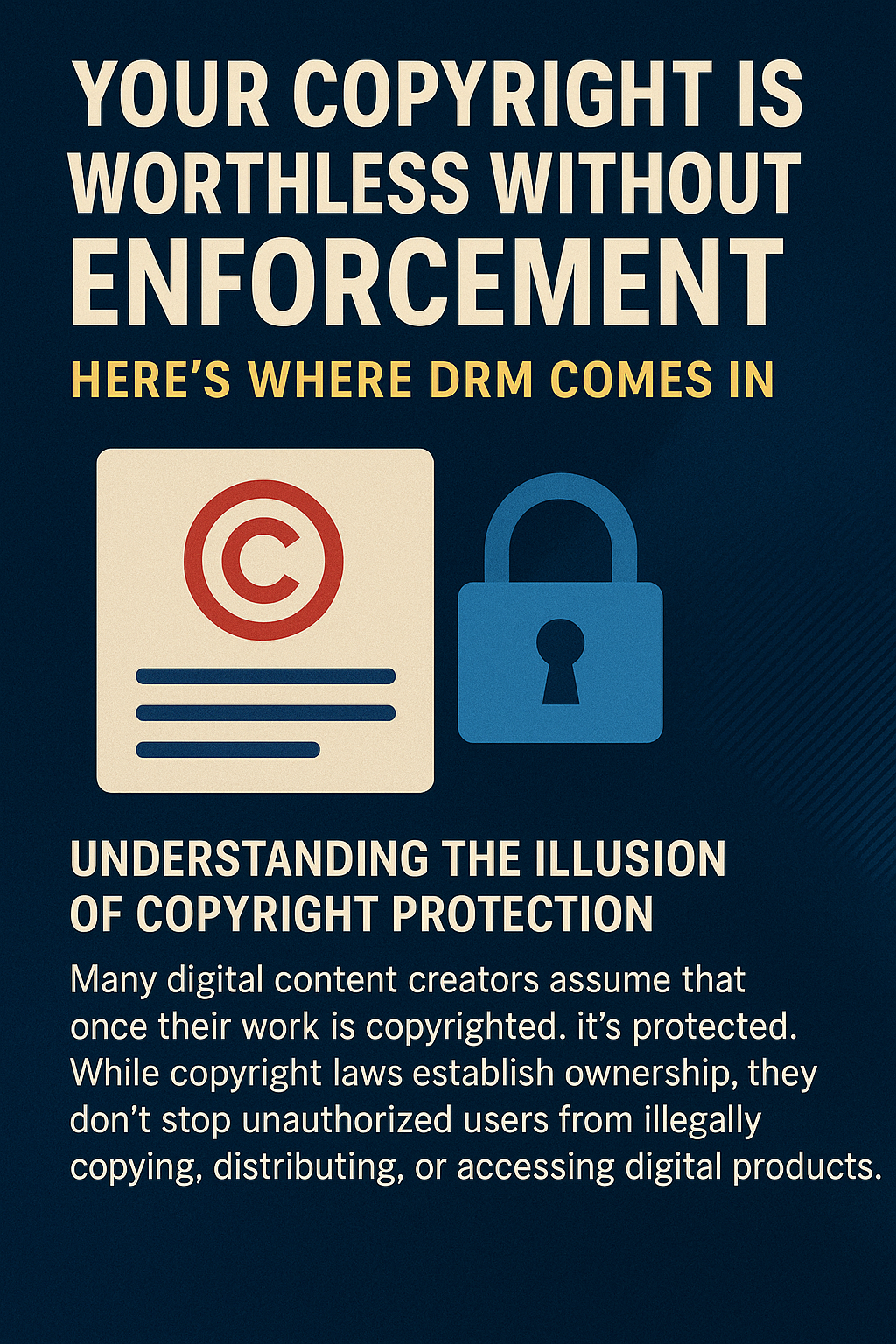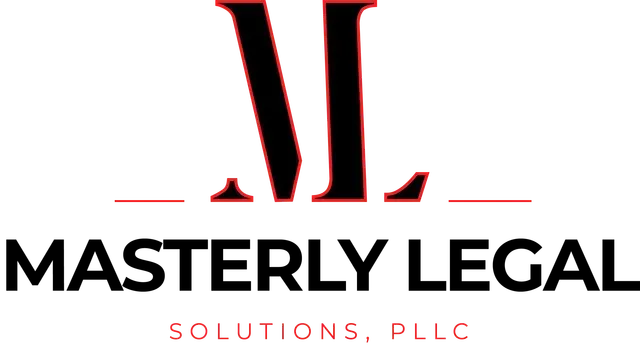Your Copyright Is Worthless Without Enforcement—Here’s Where DRM Comes In
Understanding the Illusion of Copyright Protection
Many digital content creators assume that once their work is copyrighted, it's protected. While copyright laws establish ownership, they don't stop unauthorized users from illegally copying, distributing, or accessing digital products. This creates a dangerous illusion of safety that can cost content owners revenue and control.
Copyright without enforcement is like a lock without a key—it offers no real barrier to those determined to steal, share, or misuse your intellectual property. Digital rights management (DRM) bridges this gap by applying real-world, technical enforcement to legal ownership.
The Role of DRM Technology in Copyright Enforcement
Digital rights management DRM technology protects digital media by embedding code, controls, and encryption directly into your digital files. This ensures that only authorized users can access digital content, effectively locking out unauthorized use and illegal sharing.
DRM solutions allow content creators to restrict access to their copyrighted material through:
- Access control and user verification
- Device-specific authentication
- Time-limited access permissions
- DRM codes embedded in digital products
With DRM software in place, intellectual property becomes much harder to steal, distribute, or misuse.
Who Needs DRM? A Wake-Up Call to Content Owners
If you produce any form of digital content—whether it’s audio files, digital textbooks, sensitive documents, or streaming video—you are at risk. DRM protection is essential for:
- Digital content creators distributing educational materials or eBooks
- Media and entertainment companies offering revenue-generating content on streaming services
- Course creators and educators protecting their original curriculums
- Software developers securing end-user license agreements and executable files
- Businesses managing customer data and proprietary content
Without DRM tools, these industries face serious vulnerabilities from online piracy, torrent sites, and unauthorized distribution.
The Growing Threat of Online Piracy and DRM Circumvention
Piracy is no longer limited to major movie studios. Today, any creator can find their digital files listed on torrent sites, shared through dark channels, or cloned on lookalike websites. Worse, many of these platforms actively promote DRM-free content to attract users looking to circumvent protection.
This unauthorized usage not only infringes copyright laws but severely disrupts legitimate revenue streams. Once your digital assets are leaked or misused, you lose control—and recovering that control without DRM is near impossible.
Key Benefits of Implementing DRM Systems
DRM systems offer more than just file protection. They empower content providers to:
- Restrict users by IP address, geography, device, or role
- Secure files with encryption and tamper-proofing mechanisms
- Manage access to only authorized users through authentication
- Control access to revenue streams and premium content
- Track usage to monitor for unauthorized distribution or downloads
By integrating DRM into your digital asset management strategy, you uphold data security, protect digital media, and meet data privacy regulations.
How Digital Rights Management Works
At its core, DRM technology works by limiting how, when, and by whom digital content can be accessed. This is achieved through a mix of licensing agreements, encryption, and user authentication:
- Only users with permission can open or view content
- DRM restrictions dictate if content can be copied, printed, or shared
- Digital watermarking links content to specific users to trace leaks
- Time-limited access ensures that files expire after a defined window
DRM helps organizations uphold copyright laws while allowing legitimate users to consume protected content safely.
The False Sense of Security in Static Copyright Notices
Many content creators believe that placing a copyright notice or terms-of-use statement on their digital products is enough. However, these static warnings are easily ignored or stripped.
Without a system to enforce rights management, your sensitive data, educational modules, or downloadable files become an easy target. DRM enforcement makes it clear: access is earned, not assumed.
DRM and the Law: Meeting Regulatory Expectations
Data protection regulations such as GDPR, CCPA, and HIPAA now require organizations to secure sensitive data. Failing to implement DRM restrictions could be viewed as a compliance failure.
Enterprise rights management is no longer optional—it is a standard for data privacy and copyright enforcement. DRM protection proves due diligence in safeguarding both intellectual property and customer data.
Industry-Specific DRM Applications
Different sectors benefit from tailored DRM solutions to protect intellectual property rights:
Education and Digital Publishing
- Digital textbooks
- Academic research
- Licensing agreements
Software and App Developers
- End-user license agreement enforcement
- Activation and key validation
Media and Entertainment
- Streaming services
- Audio files and video content
- Revenue-generating content platforms
Corporate and Enterprise Use
- Sensitive information sharing
- Internal communication protocols
- Intellectual property management
In all cases, DRM software enables content creators to defend their digital rights and business models.
Common Misconceptions About DRM
Many assume DRM systems are hard to implement, costly, or interfere with user experience. But modern DRM solutions are:
- Scalable for businesses of all sizes
- Flexible across platforms and devices
- Seamless for legitimate users
DRM is not about restricting freedom—it's about empowering content owners to maintain control and revenue integrity.
Choosing the Right DRM Tools for Your Needs
Not all DRM solutions are created equal. Choosing the right one means considering:
- Type of content (video, documents, software, etc.)
- Number of users or access points
- Required restrictions (printing, copying, time limits)
- Integration with existing digital asset management tools
- Compliance with industry standards and data privacy regulations
A tailored DRM report can help identify vulnerabilities and recommend the best fit.

DRM Helps Organizations Scale Securely
As your digital business grows, so does your exposure to risk. DRM tools make it possible to expand your offerings, reach wider audiences, and share sensitive documents—without sacrificing protection.
Effective DRM solutions scale with your growth, enabling you to protect intellectual property across thousands of devices and users.
The Real Cost of DRM-Free Distribution
Choosing not to use DRM is a decision—and often a costly one. Without proper protections, your content can be accessed, duplicated, and shared by unauthorized users within minutes of release.
This translates into:
- Lost revenue from non-paying users
- Damaged brand credibility
- Reduced incentive for innovation
- Increased risk of copyright infringement lawsuits
You worked hard to create your digital content. DRM ensures you continue to benefit from it.
Don’t Wait Until Your Content Is Stolen
By the time your intellectual property appears on torrent sites, it’s already too late. DRM codes, restrictions, and access controls serve as a proactive firewall against exploitation.
Protecting your digital rights before you publish is the smartest move a content provider can make.
Why Digital Rights Management Is Important for Enforcing Copyright
Many content owners don't realize that traditional copyright laws alone are not enough to prevent users from illegally accessing, sharing, or modifying their work. Digital rights management is important because it transforms passive ownership into active protection. By using DRM, you can prevent unauthorized users from copying or distributing your content, ensuring that only legitimate users gain access.
Advanced DRM systems give you the ability to restrict access to specific devices, meaning your digital assets can’t simply be forwarded or downloaded elsewhere. This level of access control helps prevent users from engaging in copyright infringement and keeps your revenue-generating content in the hands of paying customers. Ignoring this critical protection invites risk, theft, and loss—DRM makes sure your rights are more than just a formality.
Why Digital Rights Management Is Important for Enforcing Copyright
This paragraph highlights the critical role of DRM in protecting digital content and preventing misuse, directly tying in the importance of digital rights management.
Would you like additional keyword placements or a different section title using that phrase more explicitly?
Contact Us for a Free Consultation on Digital Rights Management
Digital rights management is more than a security feature—it's a business necessity for anyone distributing content online. If you're unsure whether your digital assets are truly protected, now is the time to act.
At Masterly Trademarks, we specialize in helping content owners, educators, media companies, and digital product developers implement robust DRM systems that align with their goals and industry requirements.
Don't wait for unauthorized users to take advantage of your hard work. Contact us at (972) 236-5051 to book your free consultation. Let us walk you through the best DRM solutions to secure your copyrighted material, enforce your rights, and protect your future revenue.
You might also like



